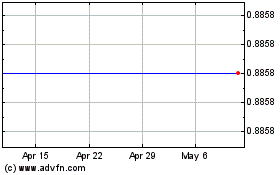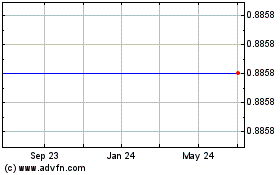By Brian Blackstone
LONDON -- Tidjane Thiam is putting the "Suisse" back into Credit
Suisse.
Two years into a three-year overhaul, the Credit Suisse Group AG
chief executive has returned the banking giant to its Alpine roots
by building up its Swiss unit and, more important, expanding its
management of wealthy clients' money, long a staple of Swiss
banks.
The process has been rocky because it meant scaling back
investment banking and moving the bank's power centers from New
York and London to Zurich, while selling toxic assets and settling
years-old legal claims. As a result, Credit Suisse posted losses in
2015 and 2016.
But it has paid off recently, with profit of 1.1 billion Swiss
francs ($1.1 billion) through September 30 on 4% revenue growth.
After battering the bank's stock price last year amid doubts over
its strategy, investors have lifted shares by nearly 70% since
mid-2016. Still, they remain 30% below from when Mr. Thiam launched
the strategy in October 2015.
That is largely because of $10 billion in new equity the bank
issued to boost capital, partly so that it could hang on to its
prized Swiss unit. Its total market capitalization is back where it
was before the revamp began.
"Based on our heritage, Swiss identity and our strengths, this
ambition of being a leading wealth manager was the right one," Mr.
Thiam said in an interview last week. "When we go abroad, being
Swiss is a positive for all our potential clients."
Mr. Thiam -- who comes from Ivory Coast, was educated in Paris
and spent much of his career in London, most recently as CEO of
U.K. insurer Prudential -- would seem an unlikely champion of Swiss
banking, an industry as closely associated with Switzerland as
skiing and watches.
Shrinking the bank was a key first step.
At the bank's investors' day conference last week in London,
Credit Suisse announced cost-savings targets and said it would
return half of its profit to shareholders in 2019 and 2020 through
share buybacks and dividends, prompting a rise in shares. Analysts
were upbeat in particular about the target to bring total costs
from around 18 billion francs this year to 16.5-17 billion francs
by 2019, as well as the bank's use of fintech to cut compliance
costs.
There are risks to the bank's focus on its home turf while
managing money globally. Credit Suisse is now slimmer than it once
was and less exposed to trading and investment banking, which,
though risky, can be highly profitable. While Switzerland is one of
the safest markets in the world, the country also has negative
interest rates and a frothy housing market, both of which could
cause trouble for its banks.
U.S. tax reform is another uncertainty. Although it could be a
positive in the long term by raising earnings and economic
activity, Credit Suisse and other banks would see a decline in the
value of deferred tax assets -- which are tax credits and
deductions from crisis-era financial losses -- if the corporate tax
rate is cut from 35% to 20%. Credit Suisse would have to take a
$2.1 billion charge against profit the year the bill is signed,
though it wouldn't affect the bank's capital base.
Looking ahead, much depends on whether Credit Suisse can pivot
from what Mr. Thiam dubbed the "Greek tragedy" of 2016, when the
bank was beset by heavy losses and internal strife, to a "virtuous
circle" whereby wealth management and investment banking generate
fees from rich clients.
A promising trend: Asia is producing one new billionaire -- or
potential client -- every other day. "What he's doing in wealth
management is internationalizing it toward Asia. They profit from
the Swiss label and Swiss reputation, but the real business is in
Asia," said Tobias Straumann, a lecturer at University of
Zurich.
It is a crowded field. Credit Suisse's biggest Swiss competitors
including UBS Group AG have pushed aggressively into Asian wealth
management. Credit Suisse's 190 billion francs in managed wealth
there only account for about 2% of total wealth in the region, Mr.
Thiam said. "There's so much growth to go for. There's no way we're
going to run into each other."
To succeed, Mr. Thiam, 55, must integrate his slimmer investment
bank into a one-stop shop for wealth management, lending and
advisory services. An example: a client in Southeast Asia invested
$245 million with Credit Suisse's wealth managers. He then hired it
to finance construction of an $850 million factory. The investor is
using the bank to launch an initial public offering in two years'
time.
"You get into this virtuous circle, and he keeps adding to his
$245 million," Mr. Thiam said.
But it hasn't been a smooth ride. Financial markets grew
risk-averse after Credit Suisse disclosed its new direction, making
it harder to sell tens of billions of dollars of complex, long-term
derivatives and other assets accumulated before the financial
crisis and its aftermath.
"It was the worst kind of Greek tragedy moment," Mr. Thiam said.
"You come in saying you want to stop doing A, and A blows up in
your face before you can actually get rid of it."
For his part, Mr. Thiam insists that 2016 was actually his
team's best year so far. The key is whether investors and the Swiss
public come around to that view.
"I think people are just happy that somebody is cleaning up the
mess; that has been overdue for a long time," the University of
Zurich's Mr. Straumann said.
Write to Brian Blackstone at brian.blackstone@wsj.com
(END) Dow Jones Newswires
December 07, 2017 05:44 ET (10:44 GMT)
Copyright (c) 2017 Dow Jones & Company, Inc.
Credit Suisse (NYSE:CS)
Historical Stock Chart
From Mar 2024 to Apr 2024

Credit Suisse (NYSE:CS)
Historical Stock Chart
From Apr 2023 to Apr 2024
